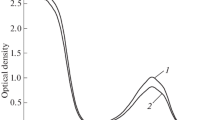Abstract
The effect of different concentrations of monosilicic acid on the sorption capacity of quartz sand, diatomite, zeolite, and brown coal with respect to cadmium and arsenic has been studied in laboratory conditions. The applicability of different adsorption models, including exponential, semilogarithmic, and linear dependences, as well as the Langmuir and Freundlich equations, has been compared. An increase in monosilicic acid concentration from 0 to 2 mM increased the sorption capacity of all materials. It has been suggested that either the interaction of monosilicic acid with a pollutant takes place directly in the solution followed by sorption of the reaction products on the surface or in the pores of the sorbent, or first adsorption of the monosilicic acid by the sorbent occurs followed by interaction of the sorbed silicic acid with cadmium and arsenic; it is also possible that both process proceed in parallel.
Similar content being viewed by others
References
Aptikaev, R.S., Arsenic compounds in soils of nature and anthropogenic landscapes, Cand. Sci. (Biol.) Dissertation, Moscow, 2005.
Vodyanitskii, Yu.N., Arsenic transformations in polluted soils, Agrokhimiya, 2013, no.4.
Vodyanitskii, Yu.N., Natural and technogenic compounds of heavy metals in soil, Eurasian Soil Sci., 2014, vol. 47, no.4.
Vodyanitskii, Yu.N., Ladonin, D.V., and Savichev, A.T., Zagryaznenie pochv tyazhelymi metallami (Soil Pollution by Heavy Metals), Moscow, 2012.
Goncharuk, V.V., Soboleva, N.M., and Nosonovich, A.A., Physicochemical aspects of soil and hydrosphere pollution by heavy metals, Khim. Interesah Ustoich. Razvit., 2003, vol. 11, no.6.
Ladonin, D.V., Heavy metal compounds in soil: problems and methods of study, Eurasian Soil Sci., 2002, vol. 35, no.6.
Ladonin, D.V., The effect of iron and clay minerals on the adsorption of copper, zinc, lead, and cadmium in the nodular horizon of podzolic soil, Eurasian Soil Sci., 2003, vol. 36, no.10.
Motuzova, G.V., Aptikaev, R.S., and Karpova, E.A., Fractionation of soil arsenic compounds, Eurasian Soil Sci., 2006, vol. 39, no.4.
SanPiN (Sanitary Regulations) no. 2.1.4.1074-01: Drinking Water. Hygienic Norms for Water Quality of Centralized Drinking Water Supply Systems. Quality Control, Moscow: Minist. Health Russ. Fed., 2015.
Arsenic: Environmental Chemistry, Health Threats and Waste Treatment, Kevin, H.K., Ed., Chichester, 2009.
Bocharnikova, E.A. and Matichenkov, V.V., Influence of plant association on the silicon cycle in the soil-plant ecosystem, Appl. Ecol. Environ. Res., 2012, vol. 10, no.4.
Contaminant geochemistry and Kd values, in Understanding Variation in Partition Coefficient, Kd, Values, vol. 2: Geochemistry and Available Kd Values for Selected Inorganic Contaminants, Washington: U.S. Environ. Prot. Agency, 1999, ch.5.
Conway, G.R. and Pretty, J.N., Unwelcome Harvest: Agriculture and Pollution, London, 2013.
Dresler, S., Wojcik, M., Bednarek, W., et al., The effect of silicon on maize growth under cadmium stress, Rus. J. Plant Physiol., 2015, vol. 62, no. 1. doi 10.1007/ s11270-012-1378-z
Esfahani, A.R., Firouzi, A.F., Sayyad, G., and Kiasat, A., Isotherm study of cadmium adsorption onto stabilizedzerovalent iron nanoparticles, Agron. Plant Prod., 2013, vol. 4, no.12.
Frimmel, F.H. and Huber, L., Influence of humic substances on the aquatic adsorption of heavy metals on defined mineral phases, Environ. Int., 1996, vol. 22, no. 5. doi 10.1016/0160-4120(96)00040-2
Jordan, N., Lomenech, C., Marmier, N., et al., Sorption of selenium (IV) onto magnetite in the presence of silicic acid, Colloid Interface Sci., 2009, vol. 329, no. 1. doi 10.1016/j.jcis.2008.09.052
Komárek, M., Vanek, A., and Ettler, V., Chemical stabilization of metals and arsenic in contaminated soils using oxides -a review, Environ. Pollut., 2013, vol. 172, pp. 9–22. doi 10.1016/j.envpol.2012.07.045
Kumpiene, J., Lagerkvist, A., and Maurice, C., Stabilization of As, Cr, Cu, Pb and Zn in soil using amendments–a review, Waste Manage, 2008, vol. 28, no. 1. doi 10.1016/j.wasman.2006.12.012
Lindsay, W.L., Chemical Equilibria in Soil, New York, 1979.
Mamindy-Pajany, Y., Hurel, C., Marmier, N., and Roméo, M., Arsenic (V) adsorption from aqueous solution onto goethite, hematite, magnetite and zero-valent iron: effects of pH, concentration and reversibility, Desalination, 2011, vol. 281, pp. 93–99. doi 10.1016/ j.desal.2011.07.046
McBride, M.B., Simon, T., Tam, G., and Wharton, S., Lead and arsenic uptake by leafy vegetables grown on contaminated soils: effects of mineral and organic amendments, Water, Air Soil Pollut., 2013, vol. 224, no. 1. doi 10.1007/s11270-012-1378-z
Moreno-Jiménez, E., Esteban, E., and Peñalosa, J.M., The fate of arsenic in soil-plant systems, Rev. Environ. Contam. Toxicol., 2012, vol. 215, pp. 1–37. doi 10.1007/978-1-4614-1463-6_1
Pehlivan, E. and Arslan, G., Comparison of adsorption capacity of young brown coals and humic acids prepared from different coal mines in Anatolia, Hazard. Mater., 2006, vol. 138, no. 2. doi 10.1016/j.jhazmat. 2006.05.063
Shaheen, S.M. and Tsadilas, C.D., Influence of fly ash and sewage sludge application on cadmium and lead sorption by an acidic Alfisol, Pedosphere, 2010, vol. 20, no. 4. doi 10.1016/S1002-0160(10)60033-1
Schindler, P.W., Furst, B., Dick, R., and Wolf, P.O., Ligand properties of surface silanol groups. I. Surface complex formation with Fe3+,Cu2+, Cd3+, and Pb2+, Colloid Interface Sci., 1976, vol. 55, no. 2. doi 10.1016/ 0021-9797(76)90057-6
Su, C. and Puls, R.W., Arsenate and arsenite removal by zerovalent iron: effects of phosphate, silicate, carbonate, borate, sulfate, chromate, molybdate, and nitrate, relative to chloride, Environ. Sci. Technol., 2001, vol. 35, no. 22. doi 10.1021/es010768z
Swedlund, P.J. and Webster, J.G., Adsorption and polymerization of silicic acid on ferrihydrite, and its effect on arsenic adsorption, Water Res., 1999, vol. 33, no. 16. doi 10.1016/S0043-1354(99)00055-X
Vaculik, M., Pavlovic, A., and Lux, A., Silicon alleviates cadmium toxicity by enhanced photosynthetic rate and modified bundle sheath’s cell chloroplasts ultrastructure in maize, Ecotoxicol. Environ. Safety, 2015, vol. 120, pp. 66–73. doi 10.1016/j.ecoenv.2015.05.026
Author information
Authors and Affiliations
Corresponding author
About this article
Cite this article
Ji, X., Liu, S., Hua, P. et al. Cadmium and arsenic adsorption in aqueous systems in the presence of monosilicic acid. Moscow Univ. Soil Sci. Bull. 72, 199–206 (2017). https://doi.org/10.3103/S0147687417050040
Received:
Published:
Issue Date:
DOI: https://doi.org/10.3103/S0147687417050040




